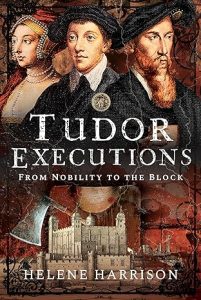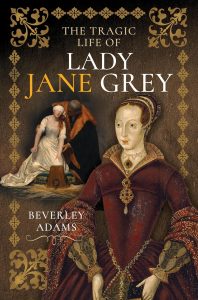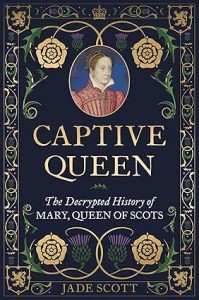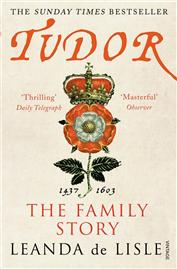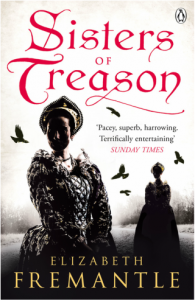‘Tudor Executions: From Nobility to the Block’ by Helene Harrison was published by Pen and Sword on 9th July.
Helene is also the author of ‘Elizabethan Rebellions: Conspiracy, Intrigue and Treason’ and runs the Tudor Blogger website.
Buy ‘Tudor Executions’:
Follow Helene on Social Media:
Website – Tudor Blogger
Facebook – Tudor Blogger
Instagram – Tudor Blogger
Twitter/X – @tudorblogger
Threads – @tudorblogger
Blue Sky – @tudorblogger
Many thanks to Helene for answering my questions.
Why did you choose this subject for your book?
I’d been researching Tudor executions for a while – I’d begun with Anne Boleyn, then Katherine Howard, then just became interested in them more generally. I find the psychology of people who are facing death in such a violent manner interesting, and the psychology of a person who can order the executions as fascinating. But what really pushed me to write the book is when I discovered that there were no dukes left in England by the end of the Tudor period. The last English duke was Thomas Howard, 4th Duke of Norfolk, who was executed in 1572. There wasn’t enough duke in England until 1623 when James I created his favourite George Villiers the Duke of Buckingham. I hadn’t realised this until I looked more deeply into the Tudor nobility and writing my first book on Elizabethan Rebellions which covered the execution of the Duke of Norfolk.
What does your book add to previous work covering this topic?
There are books on Tudor victims of the Reformation and the like, but I wasn’t able to find any books specifically covering Tudor executions, let alone exclusively the Tudor nobility. The nobility were hugely depleted during the Tudor period, with the rise of the ‘new men’ who were promoted because of their abilities rather than their nobility or connections. People like Thomas Wolsey and Thomas Cromwell reached the top of government despite having no noble connections, and this was unusual. So, I was interested in how the depletion of the Tudor nobility came about, and why.
How did you decide which executions to include?
It was difficult to narrow down the list of executions to cover in the book actually. I cover fourteen people across eleven chapters in the book – five women and nine men. Three chapters cover double executions hence the larger number of people than chapters. I also wanted each chapter to be able to be read as a standalone, as I outline in the preface, hence there is some repetition across chapters which was a very deliberate choice. I would have liked to have included the execution of Edmund de la Pole, 3rd Duke of Suffolk, in 1513, Thomas, 1st Baron Darcy, in 1537, and Thomas Percy, 7th Earl of Northumberland, in 1572, in particular. But also, to be able to go further into the executions of Henry Courtenay, 1st Marquess of Exeter, in 1538, and Henry Pole, 1st Baron Montagu, in 1539, who are both briefly covered in my chapter on Margaret Pole.
What surprised you most researching this book?
What surprised me about a lot of these executions was that there was actually very little evidence against them, or that the evidence is questionable. At least what we seem to have surviving today looks questionable. For example, a banner of the Five Wounds of Christ which was used as part of the evidence against Margaret Pole was found in a second search of her house, but not in a search six months earlier, which seems inexplicable. A lot of the dates given for when Anne Boleyn is supposed to have committed adultery can easily be proven to be wrong as she wasn’t where alleged. The Earl of Warwick seems to have been condemned alleged of plotting to escape the Tower with Perkin Warbeck but there are a lots of questions over whether that was made up. There are just quite a few instances where guilt is not cut and dried, and it just surprised me how many of those instances there actually were.
Do you think that Jane’s execution was a forerunner to that of Mary Queen of Scots? Even though Jane was never crowned or anointed Queen.
Jane Grey’s execution is the first of a queen regnant, even though she was only nominally queen for thirteen days (6th to 19th July). However, we know that a precedent had been set for executing English queens, with the executions of Anne Boleyn in 1536 and Katherine Howard in 1542. However, they were queens consort rather than queens regnant. There are similarities between the executions of Jane Grey and Mary Queen of Scots in that I think neither Mary I nor Elizabeth I wanted to go through with the executions and kept putting them off. They were polar opposites in terms of the religious divide with Jane determined to die a devout Protestant, and Mary as a martyred Catholic. But that also almost makes Jane’s a forerunner to Mary’s – both regnant queens booted from their thrones, pious, devout and ready to die for their beliefs, but Mary had been crowned and anointed where Jane was not. Mary was also a dowager queen of France as well as a former queen of Scotland. So, although Jane Grey’s execution can be seen as a forerunner to Mary’s, I think Mary’s broke new ground in terms of regicide and paved the way for the execution of her grandson, Charles I, sixty years later..


